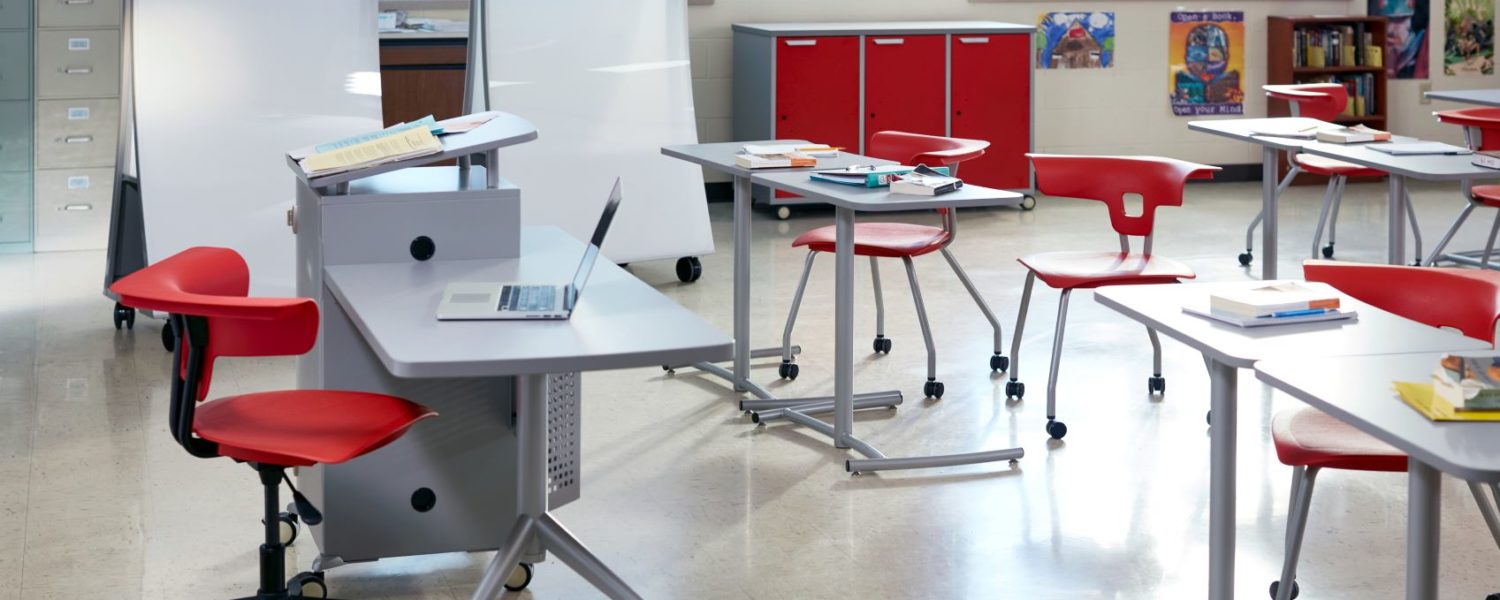As the nature of 21st century continues to evolve and change, schools have begun to move away from the traditional classroom and are embracing more modern spaces that support new and innovative ways of learning.
Because the physical classroom environment has become an extension of the teacher, choosing classroom furniture is a critical component in classroom design.
Here are a few considerations to keep in mind when buying furniture for an educational environment.
Functionality and Mobility
The modern classroom environment is flexible and collaborative and needs furniture that will support diverse learning styles. Choosing furniture that is easily reconfigurable and adaptable will allow for classroom teachers to quickly transition from individual learning to group work quickly and with little disruption to learning.
Size and Ergonomics
When choosing furniture for classrooms, it is important that it be sized accordingly to the age of the child. Adjustable seating can be quickly changed to accommodate different size students.
Furthermore, ergonomics are also important to consider because studies have shown that many students suffer from back issues due to years of sitting in uncomfortable seating. Comfortable seating and furniture in classrooms can actually help students to focus and as a result retain more of what they are learning.
Safety and Durability
Safety and durability might be two factors that seem obvious when deciding about classroom furniture, but they are often overlooked.
Because furniture for an educational environment will need to endure a great deal of wear and tear, choosing furniture with durable aluminum frames and laminate surfaces will last a lot longer than other options.
Also, it should be safe. Chairs should be sturdy and not tip easily and if using adjustable furniture, it should be easily reconfigured so fingers and hands don’t get pinched in the process.
Health Considerations
Not only should a furniture’s construction be sturdy and stable in terms of safety, it should also meet health standards. It is important to pick furniture that is made without the use of toxic chemicals. The furniture should meet the standards for low levels of VOCs. The best furniture for classrooms should be green certified.
4 HOT DESIGN TRENDS IN EDUCATION
The world of education has changed in the 21st century, and classroom design has changed along with it.
Here are four trends that are leading the way.
Flexible, Reconfigurable Spaces
Like the business world, schools are schools have moved away from traditionally designed classrooms and have adopted a flexible, open floor plan. Because students need to have furniture that can be easily rearranged and reconfigured as learning needs change during the course of the school day. Research has shown that flexible learning environments have positive impact on student learning.
Breakout Spaces
Breakout areas in the school setting are small spaces located adjacent to classrooms. Supporting the flexibility and adaptability of a space, these areas are used as alternative spaces for students to engage in small group instruction, collaboration work or individual work.
Incorporating Technology
Technology is an absolute necessity in order to create a 21st century classroom. Having reconfigurable and flexible furniture in the classroom can ease students’ interaction with technology.
Furniture that is also beneficial to integrating technology include tables with power and data ports, seats that can rotate and tables with markerboard surfaces. Creating a versatile classroom environment will enhance and support innovation, collaboration and creativity.
Sustainability
Sustainability in school design has become a major focus. Schools want to use the most environmentally friendly materials so that the materials do not contribute to harmful indoor air quality or a negative indoor environment.
Having access to natural lighting and focusing on improving acoustics so that students have a comfortable and positive learning environment has become an important part of classroom design.
These trends highlight that in the modern-day classroom, variety is really the name of the game. This generation of students are more diverse and technology-immersed than ever before.
By providing students with a variety of spaces to learn by using a free-flowing open floor plan, adaptable, technology-integrated furniture and incorporating breakout spaces into your design will create a learning environment that enhances effective teaching (and learning) for students and teachers.
This information is courtesy of Bellia, www.bellia.net. A third-generation family company, Bellia is a furniture provider focused on corporate interior design. Through strategic planning and design, they provide furniture and design services that will increase the return on your workspace.
Photo courtesy of KI














